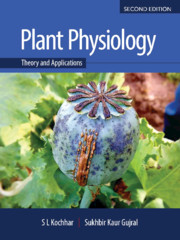Book contents
- Frontmatter
- Contents
- Foreword
- Preface to the Second Edition
- Preface to the First Edition
- Acknowledgements
- Some Common Abbreviations used in the Text
- Abbreviations for Units
- Unit I Water and Mineral Translocation in Plants
- Unit II Metabolism and Bioenergetics
- Unit III Growth and Development
- Unit IV Physiological Stress and Secondary Metabolites – Their Role in Metabolism
- Unit V Crop Physiology – An Innovative Approach
- Unit VI Breakthroughs in Plant Physiology
- Unit VII Some Experimental Exercises
- Glossary
- References
- Index
- Colour Plates
Chapter 10 - Nitrogen Metabolism
Published online by Cambridge University Press: 12 May 2020
- Frontmatter
- Contents
- Foreword
- Preface to the Second Edition
- Preface to the First Edition
- Acknowledgements
- Some Common Abbreviations used in the Text
- Abbreviations for Units
- Unit I Water and Mineral Translocation in Plants
- Unit II Metabolism and Bioenergetics
- Unit III Growth and Development
- Unit IV Physiological Stress and Secondary Metabolites – Their Role in Metabolism
- Unit V Crop Physiology – An Innovative Approach
- Unit VI Breakthroughs in Plant Physiology
- Unit VII Some Experimental Exercises
- Glossary
- References
- Index
- Colour Plates
Summary
Although the three elements carbon, hydrogen and oxygen constitute the bulk of dried plant material, nitrogen plays a vital role in plant metabolic processes. On the basis of dry weight, nitrogen is the fourth most prevalent mineral element in plants. It represents an integral component of protoplasm, including nucleic acids, proteins, growth hormones, porphyrins such as in chlorophyll and the haeme group of cytochromes, vitamin B and other primary and secondary plant metabolites.
The bulk of the air, 78 per cent by volume, comprises of molecular nitrogen (N2 or dinitrogen), an inert, odourless and colourless gas. Despite its abundance, however, higher plants are not able to convert nitrogen into a biologically useful form. For this, plants must depend on prokaryote organisms.
The main source of nitrogen for the green plants is the supply of nitrogenous compounds present in the soil. Soils contain both organic and inorganic nitrogenous compounds. Organic nitrogen compounds are abundant in the soil humus and are produced by the microbial decay of plant and animal remains through ammonification and nitrification, e.g., urea.
Inorganic nitrogenous compounds in the soil are the nitrates, nitrites and ammonia compounds. Of these, the nitrate nitrogen is the most important for plants but this, like other anions, is leached out and therefore should be replenished, in order to maintain productivity.
Nitrate Assimilation
Most species of plants absorb their nitrogen in the form of nitrates (NO3 −). Nitrogen (N2) is present in a highly oxidized form in nitrates and in a highly reduced form in amino acids. Therefore, nitrates are to be first reduced to ammonia to be assimilated by the plant.
Thus, the transport of nitrate across root cell membrane is an energy-consuming process facilitated by a carrier protein. Once within the root, nitrates may accumulate in the vacuole or else be assimilated in the root cells or transported through the xylem to the leaves for further assimilation.
Reduction of nitrate to ammonia takes place in two stages:
1. The first step in the sequence is reduction of nitrate to nitrite, catalyzed by nitrate reductase (NR) enzyme
Nitrate reductase is a ubiquitous enzyme, predominantly localized in cytosol of prokaryotic and eukaryotic cells as well. It has been extracted and purified from many groups of plants and is comprised of two identical subunits having molecular weight of ∼115 kD.
- Type
- Chapter
- Information
- Plant PhysiologyTheory and Applications, pp. 313 - 351Publisher: Cambridge University PressPrint publication year: 2020

